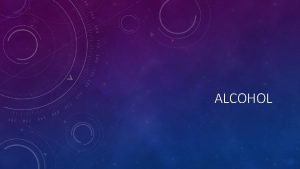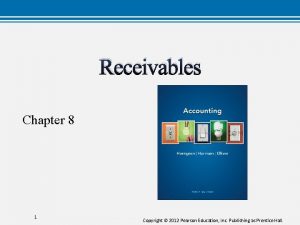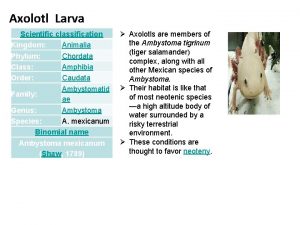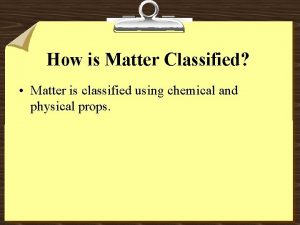ALCOHOL WHAT IS ALCOHOL Alcohol is classified as









- Slides: 9

ALCOHOL

WHAT IS ALCOHOL • Alcohol is classified as a depressant, and it can be different types of alcohol, for example, ethol alcohol (ethanol), which is used in beverages • One is for the stimulant effect and to loosen up and a second is to stop depression • It reduces the ability to think rationally and distorts judgement • Slows down vital functions – resulting in slurred speech • Disturbed perceptions and an inability to react quickly • One social use is overflowing the amount that the person needs, which leads to a lot of concequences

EXAMPLES OF ALCOHOL • There are many different types of alcohol and all of them have differing effects on the drinker and the level of alcohol in them. • Beer is typically 4. 5% alcohol content and “one drink” is considered 12 oz • Wine is typically 11. 6% alcohol content and “one drink” is considered 5 oz • Liquor is typically 37% alcohol content and “one drink” of straight liquor is considered 1. 5 oz and “one drink” of a mixed drink is also considered 1. 5 oz • Slang terms for alcohol include juice, hootch, sauce, vino & liquid courage

REASONS WHY PEOPLE USE ALCOHOL • Stress Relief: For both moderate drinkers and alcoholics, alcohol has anti anxiety properties. It can inhibit anxiety or the feeling of stress. An example is that it is a common way for people to “unwind” after work or a long day. Can also help people forget about their problems. • Peer Pressure: Many people drink when others around them are drinking. In fact, most non-alcoholics tend to drink in in social situations. An example is weddings, or football games, where alcohol is considered a part of the event itself. Though “peer pressure” often associated with young people, its not limited to those in junior high, high school, or college. Drinking is prevalent in our culture, socially accepted and legal. Peer pressure to drink alcohol can exist at any stage of life. • Social Influences: People drink to become sociable and confident • Access: It can be cheap to get ahold of and easy to obtain • Ingredients within alcohol can have a relaxing physical effect, such as hops in beer is a natural muscle relaxant

IS ALCOHOL ADDICTIVE? ? • Alcohol IS Addictive • Alcoholism is a disease affecting more then 15 million people in the United States. It has genetic, psycosocial and environmental factors that come into play, making it difficult to find one cause for the problem of alcoholism • In recovery the first step is admitting that your life has become unmanageable, which is exactly what addiction is. A state of life that is unmanageable.

EFFECTS OF ALCOHOL ON THE BODY • Short Term Effects of alcohol on the body: slurred speech, blackouts, dehydration, changes in coordination (both balance and walking) • Long Term Effects of alcohol on the body: shrinking of the frontal lobe, heart damage (cardiovascular disease), liver damage, pancreatitis, infertility, malnutrition, thinning bones (increase the risk of osteoporosis), stomach distress (bloating gas, painful ulcers), damage to central nervous system (numbness or pain in hands & feet) • Withdrawal Effects on the body: anxiety, nervousness, nausea, tremors, high blood pressure

ROUTE OF ADMINISTRATION FOR ALCOHOL • Traditional Ways of consuming alcohol: • Oral ingestion of a liquid, it can take 20 -30 minutes to take effect, potential adverse effects are vomiting, damaged stomach • Without food alcohol gets into your system faster so if you choose to drink eat something with it or pace it with water • Creative Ways of consuming alcohol: • • If you’re a total animal you can butt-chug which is consuming alcohol thru the anus via a funnel • This method of ingestion is worse then orally because the lower gastrointestinal tract can’t break it down as effectivly • This method is used to bypass gag reflex and to absorb faster Gummy Bears/Jello Shots • Still an oral method but in food form rather then a liquid

LEGAL & SOCIAL ISSUES WITH ALCOHOL • ABC – Alcoholic Beverage Control • Cannot serve: No Person under 21, Fake ID, Expired ID, No ID if under 35, No free drinks • Considering extending the cut-off serving time to 4 am from 2 am • Consequences of Alcohol Use: • DUI, Rehab, Community service, Weakened liver, Cirrhosis of the liver, hangovers • Social Issues • Have you ever seen a video of yourself drunk? If you go out with a group of friends who is going to volunteer to drive anyone? • Uber or Lyft is cheaper then a DUI

LEGAL & SOCIAL ISSUES WITH ALCOHOL CONT. • Alcohol as a social issue is used for self-medication. There is a misunderstanding of alcohol and it’s “benefits”. Alcoholism does lead to cultural systematic issues in the United States. 13. 8 million Americans have a drinking problem, with over 15 million suffering from full-blown alcoholism. • Alcoholism can lead to an increase in joblessness, homelessness, assaults and mental health issues • Socially it leads to a lack in an individual’s judgement to have rational problem solving skills • Consequences can include being monitored via ankle bracelet, loosing your drivers license, having a forced curfew and more.

















